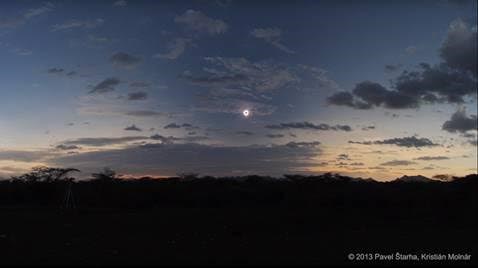This content was originally published by the Longmont Observer and is licensed under a Creative Commons license.
It depends on how you are looking… but be careful when you look.
For this part of the eclipse primer, I want to describe what you will look for and how you will look for it. I also want to advertise the total solar eclipse. You may be wondering if it worth all this work to get time off, travel with millions of other people to a strip of land somewhere across the nation, and brave food, gas, and internet/phone shortages.
It is…but you need to prepare just a bit…
First, you must remember to not look at the sun at any time until the disk of the sun is hidden by the moon. We are hard wired to not look at the sun normally, but when we get excited about a solar eclipse, it is not too hard to press the mental override button and start taking peeks. I have a friend who looked at the partial phase of a solar eclipse when it was pretty low to the horizon and looked fairly dim. He could blink 30 years later and still see the burn image on his retina. Don’t do it.
For this article, like the last, I’ll use Casper, Wyoming as my example city for times and angles. You’ll need to use www.cleardarksky.com or an app to determine how times vary where you will be going. Let’s say you have perfectly clear skies. The first nip in the side of the sun occurs at 10:22:18 am MT. The sun will be 42.6 degrees up in the sky (0=horizon, 90= overhead) and standing above the 118.2 degree position on the horizon (135 degree is southeast, 90 degrees is east, so it will be up in the EES sky). That bite will appear at the 287.7 degree position angle, which is about the 10 o’clock position on the face of the sun (noon is the northward-most point on the sun).

(This would be the 3:30 position on the sun if north point was on top.)
The sun is pretty blank right now (like this image) but if a large sunspot cluster rotates into view, that will make the solar disk more interesting. If you want to check the sunspot activity, go tohttp://spaceweather.com/ and look at the yellow circle on the left. It is a live image (just minutes old) of the sun taken from the SOHO spacecraft. Currently it looks like this:
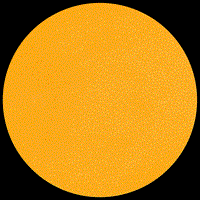
There are no sunspots. Boring.
But STOP! How do you see this part of the eclipse? You need sun-safe glasses (explained by NASA in the Part 2 article) or a sun-safe filter firmly fixed to the front of a telescope. I strongly recommend NOT using the solar filers that screw into the back of a telescope eyepiece. They heat up - a lot - and can crack without warning and blast your eye with more sunlight than you can imagine destroying your vision in so little time you won’t be able to blink or move fast enough. Throw those eyepiece filters away.
Also, don’t use binoculars. I’ve never seen sun safe filters for binoculars. Any filters you use CAN’T be allowed to fall off, or get scratched, or cracked, or punctured. Handle your sun-safe glasses with care as well. Maybe bring along an old glasses case to keep them in when not in use.
From here the moon will slide across the sun’s face covering more and more. Keep using all eye protection methods. (Cameras will get fried without protection as well. Don’t destroy your expensive DSLR or phone/pad camera taking unfiltered pictures of the sun).
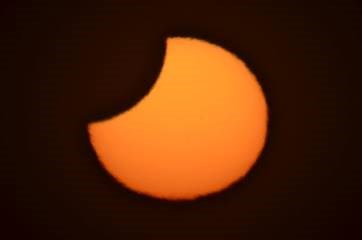
In the minutes before totality, the sun will become a very thin sliver.

When this is happening, atmospheric turbulence (probably) will cast traveling waves of slight shadowing across the land around you and on the sides of buildings. These are called shadow bands (great name, no?)
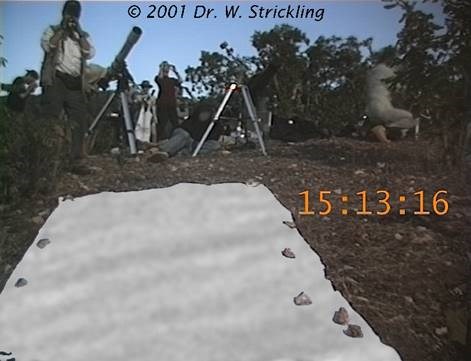
Shadows of objects, including you and your friends, will go from their normal fuzzy edge to a very (unusually) sharp edge. The gaps between leaves in trees will cast many images of the sun on the ground. This is the pinhole camera effect. A pinhole camera is also a great way to view the partial phase of a solar eclipse. https://www.jpl.nasa.gov/edu/
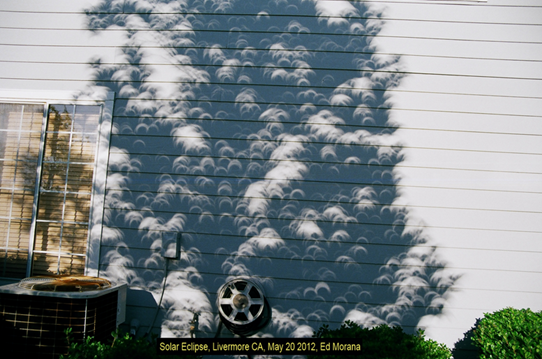
Just a few seconds from totality, the sun will be peeking through gaps in crater walls and mountain ranges on the edge of the Moon. These pieces of sunlight are called Baily’s beads.
If you glance to the west, you’ll see the darkness of the eclipse racing towards you. The blue sky will be fading out across a vast section of horizon and upward.
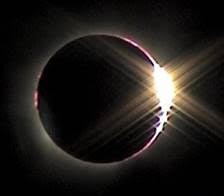
When the last bit of sunlight is peeking through the last gap, you get the diamond ring moment of the eclipse. The suns atmosphere is about to appear – called the corona. As this last bit of raw sunlight winks out, it is finally safe to look at the sun without glasses, filters, or a pinhole camera.
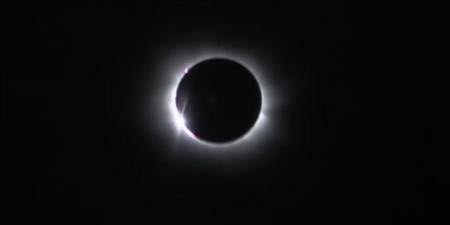
It isn’t until 11:42:30 am that totality begins and you can watch the eclipse for the next 2 minutes and 27 seconds without eye protection. But have it on hand for the return of the sun. It has taken over an hour and ten minutes to get to this point. This 2.5 minute totality time will go by quickly. Try not to waste it playing with telescopes or cameras (more on this in Part 6) unless this is your 3rd or 5th total solar eclipse. Just take it in.
With the sun completely blocked, it will be an eerie form of night outside with a sunset-like glow around the horizon. The stars will come out (see diagram below). Animals will quiet down, or some may call out when there were quiet before. In crowds, people around you may stand in silent awe, but some may start laughing. Some may start to cry. Ask them afterward if they remember laughing or crying if friends of yours do that. Ask them if you responded that way. The wind strength often changes abruptly and you’ll notice a temperature drop – both from the air and the lack of direct sunlight hitting your skin.
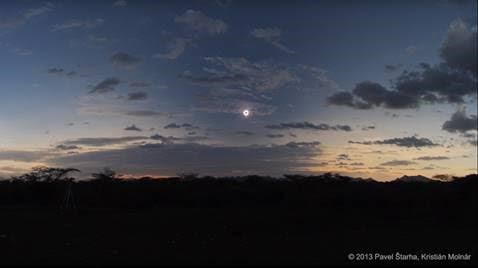
The sun’s corona will be visible fully now, and prominences may peek over the edge of the moon; red loops of hot gasses trapped in magnetic fields around the sun.
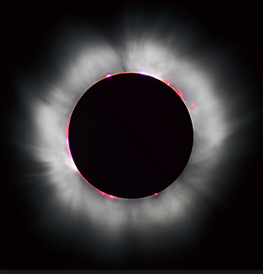
The brightest objects in the sky that will appear are the planet Jupiter over in the southeast sky to the left (facing south). Mercury will be to the immediate east-southeast of the sun (left). Mars will be to the right. Venus further right. The brightest non-sun star in the sky, the winter favorite Sirius, will be down in the southwest sky if you don’t have nearby trees or buildings.
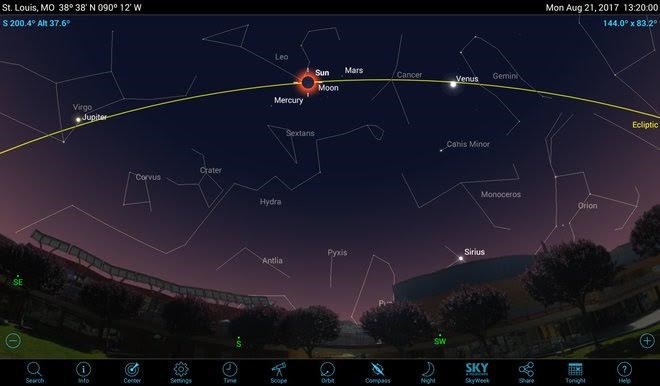
Way too soon, the western sky will begin to get brighter. Get your glasses/eye protection ready. You will see your second diamond ring phase (glasses on!) that rapidly morphs to Baily’s beads and then the sliver of sun returns. Watch for the shadow bands again, if you missed them before. While everyone else hops in cars and crowds the roads, sit back and enjoy the partial eclipse in reverse and head home a bit later (maybe have a picnic lunch with unusually sharp shadows cast by your food).
Our fifth batch of useful Eclipse Information links (related to the text above):
Clear Sky Chart: http://cleardarksky.com/csk/ (There are smart phone/pad apps for this site as well.)
Spaceweather Blog: http://spaceweather.com/
NASA/JPL Pinhole Camera activity: https://www.jpl.nasa.gov/edu/learn/project/how-to-make-a-pinhole-camera/
Another NASA eclipse pinhole projector activity: https://eclipse2017.nasa.gov/2d3d-printable-pinhole-projectors
Bio:
John Ensworth works from Longmont as the Principle Investigator for the NASA Science Mission Directorate Earth and space science education product review through the IGES (The Institute for Global Environmental Strategies – www.strategies.org) . He is in his 14th year running this review. He is an astronomer (from the 2nd grade onward) and became a meteorologist (in the 5th grade) when a thunderstorm in Arizona rained on his telescope when the weather service had only forecasted a 10% chance of rain. He has college degrees in physics and astronomy and climatology and a graduate degree in meteorology and earth science. He lectures at the Little Thompson Observatory in Berthoud, the Estes Park Memorial Observatory in Estes Park, and for a number of online universities. He built and runs a backyard observatory near Pace and 17th in northeast Longmont where he has lived for 8 years with his wife, daughter, son, and two cats. Invitations to open house nights at this observatory, LTO, and EPMO will be posted with future discussions when they are scheduled.
Forecasting severe weather and snow amounts via text lead to this column. He began texting friends about the weather right after the September 2013 flood. The readers of this column will, hopefully, keep him honest in what he ‘thought’ he had forecasted for ‘the most recent’ storm.
